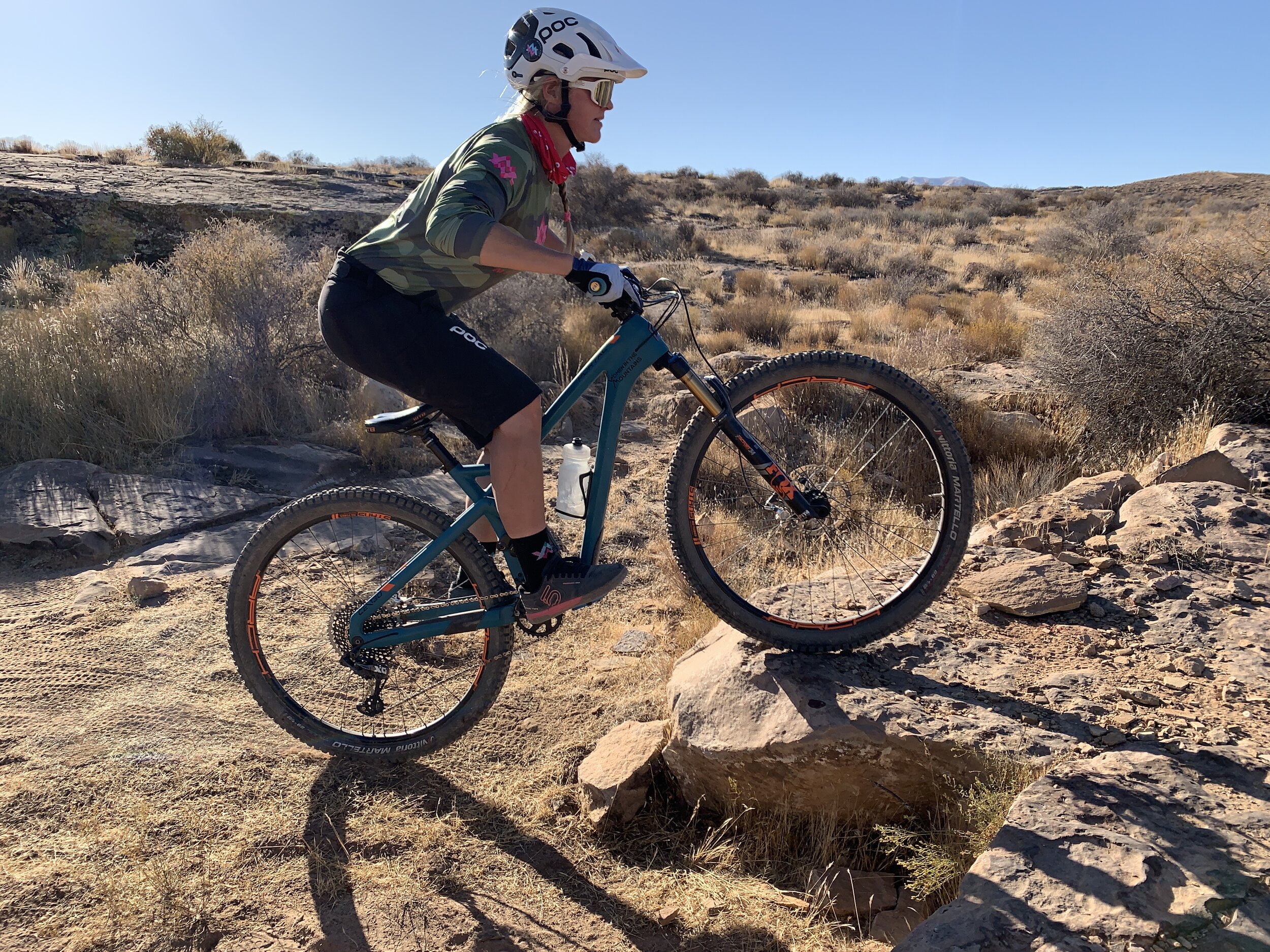Much Ado about Wheels
One of the first choices you’ll make when selecting a new bike is wheel size. Many riders have deep held convictions about the matter and are prepared to passionately extol the virtues of their preference. Fortunately, you don’t need to pick a size (or side) randomly; instead, you can make an educated choice based on your riding preferences, your physical stature, and what feels like the right wheel for you.
Mountain-bike wheels used to have a standard 26-inch diameter, but they have mostly been replaced by 29-inch (29ers) and 27.5-inch (also referred to as 650b) wheels. Besides the obvious, what’s the difference? We’re glad you asked. All other things being equal, 29ers generally have better traction, more efficient attack angles and better stability. On the other hand, 27.5-inch wheel bikes generally provide faster acceleration, are more agile, weigh less, and favor shorter riders. We’ll go into more detail below.
29-Inch Wheel (29er)
Bikes with 29-inch wheels are known for their smooth ride and ability to roll over obstacles with ease. Riding a 29er will help you feel increased confidence when riding over logs, roots and technical rocky sections. Larger wheels generate greater traction with increased tire-to-dirt contact, and will excel on loose climbs and corners! One big advantage of a 29er is increased stability. This is due in part to a longer wheelbase, but primarily to the bottom bracket being positioned lower than the centerline of the axle. This results in the feeling of riding “inside” the bike, as opposed to the “on top of the bike” feeling of 26-inch wheels. Larger wheels require less effort to keep in motion once rotating, and are more efficient for longer rides.
On the flip side, the longer wheelbase of 29ers can make tight corners more difficult (though improved engineering has lessened this difference). In addition, larger wheels are heavier and have decreased acceleration efficiency, which can give the bike a less-responsive feel. This can be aggravating on steep inclines, where bursts of acceleration are often helpful.
Big Wheels for Small People
Bikes with 29-inch wheels are often overlooked as well suited for smaller riders since bigger wheels generally means bigger bikes. It once seemed impossible to accommodate a mid-to-high travel bike with 29-inch wheels on a small or extra-small frame. Fortunately, the bike industry always finds a way to expand our horizons, and has been able to adjust bike geometries to accommodate 29-inch wheels on full-suspension bikes for all sizes of riders. More and more women have been ditching their 27.5-inch wheels for a new 29-inch wheel mountain bike! Ibis in particular has been one company on the forefront of creating efficient small 29er mountain bikes! Many bike designers cite carbon as a leading innovator for allowing 29ers to fit small frames appropriately, as well as newer and better suspension designs.
However, not all bike brands have created equally proportioned 29ers or even sell small or x-small 29-inch wheel mountain bikes. A well constructed 29-inch wheel mountain bike should accommodate ample standover height, no toe overlap (toes hitting the front tire) and the frame design should not feel exaggerated with an extra slack headtube angle.
29-inch wheel mountain bike options are especially limited for riders whose height is around 5 feet or shorter. In this case 27.5-inch wheels often provide more and better options in regards to fit. If you are a shorter rider looking for a 29er, here are a few recommendations!
Here are a few XS mountain bikes with mixed-wheels for 2023 (all 15% off at Backcountry!):
Santa Cruz Bicycles 5010 Carbon C S Mountain Bike
Juliana Furtado Carbon CC X01 Eagle AXS
Juliana Roubion Carbon XT Mountain Bike
Here are a few XS mountain bikes with 29 inch wheels available in an XS frame size:
Juliana Joplin Carbon C GX Eagle AXS Mountain Bike
27.5-Inch Wheel (650b)
Bikes with 27.5-inch wheels are often referred to as the “fun size”--they are nimble and agile. They have more stability than a 26-inch-wheel bike; however, the distance between the bottom bracket and centerline of the axis is not as pronounced as it is on 29ers. Compared to 29-inch wheels, 27.5-inch wheeels allow more efficient acceleration and increased maneuverability. They are better at tight cornering, are more playful, and more responsive to rider input. The quick handling and acceleration efficiency comes at a price, however. Bikes with 27.5-inch wheels don’t get as much traction or roll over obstacles as smoothly as their 29-inch counterparts.
Mullet Bikes: Business in the Front; Party in the Back
For those who want to have their cake and eat it too, some companies now offer a “mullet” set-up that places a 29-inch wheel in the front and a 27.5-inch wheel in the back. Before you give your bike a mullet at home, keep in mind that this configuration requires thoughtful engineering with regard to bike geometry in order to create a balanced bike—not as simple as swapping wheel sizes on any old bike. However, when done well this can give you the best of both worlds—a bike that both rolls over obstacles with ease and that is playful and agile. Mullet configurations are more commonly seen on racer’s bikes, but could become more popular on trails!
All Things Considered…
Despite what you may hear in shuttle vans, there isn’t a right or wrong wheel size. In the end, it comes down to your trail preferences, riding strengths, and overall priorities. Some riders prefer 29er bikes that roll through and tackle obstacles on the trail with relative ease, while others prefer 27.5-inch bikes with their more responsive and nimble feel. 29-inch wheels maintain speed more efficiently, while 27.5-inch wheels accelerate more effectively. It is also important to mention that 27.5-inch wheels may appeal to shorter riders more, as the overall frame design tends to fit better!
It’s one thing to compare wheel-size characteristics on paper; quite another to compare them on the trail. We highly recommend you demo or test ride bikes of both wheel sizes to see which feels best for you. Many shops will deduct demo fees from the final price of the bike you decide to purchase. Once on the trail, you’ll feel the differences in handling, obstacle navigation, cornering, inertia, and momentum efficiency. And soon you, too, may find yourself on a shuttle bus evangelizing your preferred wheel size to all who can hear!
For more info on mountain bikes, check out our recent Bike Recommendations post.
The Mountain Bike Mastery Course is where we take your mountain bike skills to the next level and way beyond. Join from anywhere in the world for the most in-depth, personalized coaching possible. Make some magic on your bike with Coach Erica Tingey supporting you every pedal stroke of the way.


